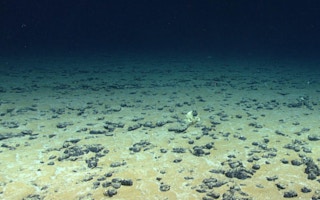A new study has found that valuable transition mineral deposits on the ocean floor may produce oxygen, providing ammunition to environmentalists pushing for a moratorium on deep-sea mining.
To continue reading, subscribe to Eco‑Business.
There's something for everyone. We offer a range of subscription plans.
- Access our stories and receive our Insights Weekly newsletter with the free EB Member plan.
- Unlock unlimited access to our content and archive with EB Circle.
- Publish your content with EB Premium.
Published in the journal Nature, the study coincides with negotiations on regulating deep-sea mining, held by the International Seabed Authority (ISA) in Jamaica. The study revealed that polymetallic nodules found on the sea floor produce “dark” oxygen – that is, oxygen generated in the depths of the ocean, without the need for photosynthesising plants.
The ocean produces about half of the Earth’s atmospheric oxygen, mainly from plankton, drifting plants, algae, and bacteria that can photosynthesise. The study by Sweetman et al reveals that the life-giving gas can be generated on the ocean floor, where there is no sunlight and photosynthesis is not possible.
The discovery was made on a stretch of the Pacific Ocean floor known as the Clarion Clipperton Zone (CCZ), where trillions of the potato-sized polymetallic nodules lay. The nodules contain metals that mining companies argue are crucial to the energy transition, such as manganese, iron, cobalt, nickel, copper. The CCZ is where industrial-scale extraction could go ahead once the ISA has approved mining regulations.
Environmentalists have long campaigned to stop deep-sea mining, arguing that not enough is known about the impact of extraction on unique, poorly understood ecosystems. Countries including Brazil, France, Germany and New Zealand have demanded a ban or precautionary pause on deep-sea mining.
Roger González from the Embassy of Panama, told the ISA Council that the dark oxygen finding “reaffirms that we need to slow down urges for exploitation and give time for science to continue studying the seabed.”
Dr Paul Johnston, a scientist working for Greenpeace, one of the campaign groups that opposes deep-sea extraction, said the ecological importance of deep-sea oxygen production “is not really known but may be highly important.”
A mining moratorium should be imposed because there is a lack of a understanding not only of the biodiversity of deep-water ecosystems, but of the ecological functions they support, he said.
The company leading the charge for deep-sea mining, The Metals Company, said that the study’s methodology was “flawed” and disputed by other scientists, it was published by a journal that has taken an anti-mining stance, and was timed to disrupt the ISA’s negotiations.
The Metals Company plans to apply for a licence to extract deep-sea minerals before the end of this year.
Ocean activist Dr Helen Scales said that if the science was flawed, the paper would not have been published, and in a highly-regarded journal after going through a peer-review process. “The only emphatic criticisms have come from people involved in the mining industry who have vested interests in the findings which could complicate their plans to apply within a year to open the first deep-sea mines,” she said in a post published by Greenpeace.
Deep-sea reserves of cobalt, nickel, copper, and manganese are estimated to be worth $8 trillion to $16 trillion. The International Energy Agency has estimated that six times more transition minerals will need to be mined by 2040 than are being extracted today, to achieve net zero emissions by 2050.
A 2021 report by non-profit Planet Tracker estimated that seafloor extraction could negatively impact the mining industry, and create environmental damage up to 25 times greater than land-based mining.








